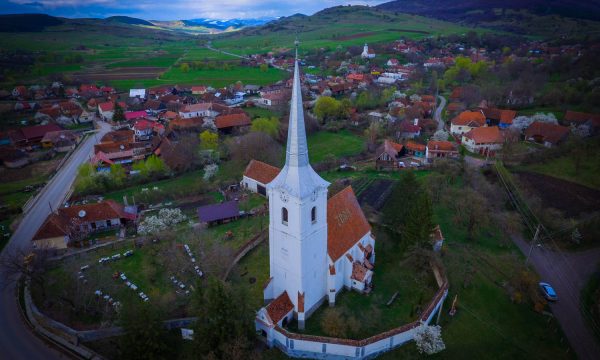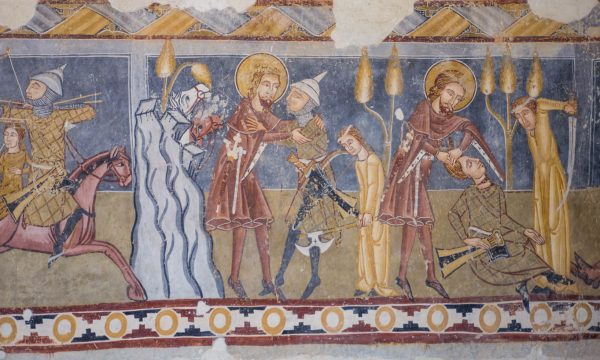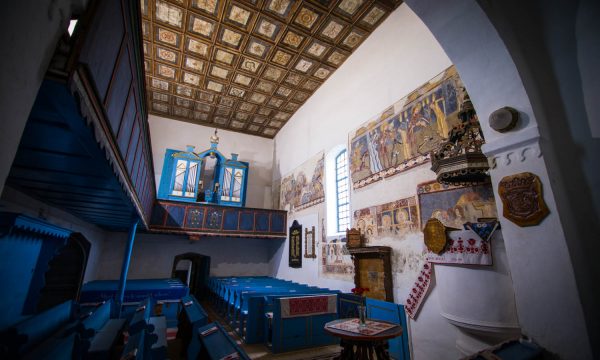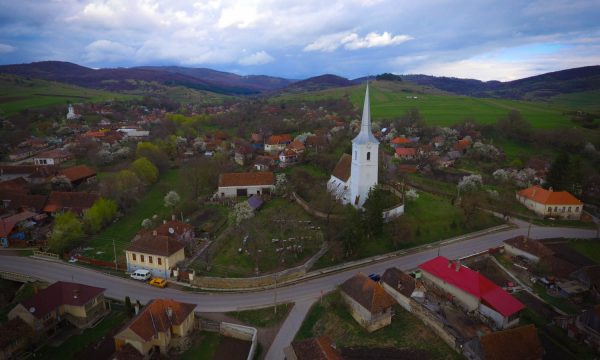Wall Painting
According to researchers the church was built in the second half of the 13th century. It is remarkable that, unlike the other churches in the area, it preserved its original Romanesque form, and its choir was not demolished in the 15th century as it was the case with many churches in this region.

The choir has a quarter-sphere dome and a semicircular closure, In 1496 a tower was built in front of the western façade, and the western gate was erected, with an Agnus Dei relief and date. Based on the details observed in the attic we established that at this time the tower was marked by red and grey rustic quoins in its corners. Its smaller bell was cast in 1545. We have information on bigger repairs carried out on the church in the 1640s, its surrounding wall was certainly built at that same time. The wooden ceiling of the nave was constructed in the 1730s, but the upper walls of the nave were significantly raised much earlier, presumably during the construction works from the 15th or 17th centuries. Its timber roof structure shows solutions characteristic of the end of the 15th century. In 1768 an armed conflict erupted with the Catholics who wanted to overtake the church, resulting in deaths. The porticos were reconstructed during the renovation from the 1790s and the inscription in a stucco frame on the triumphal arch commemorates this work. It is certain that its former much smaller medieval windows gained their current form at this time, and the honeycomb windows with leaded glass date also from this period. Between 1804 and 1806 the height of the tower was raised, and at the same time it received its late Baroque plaster surface. Its northern window was opened in 1833, which caused significant damage to the medieval murals. Its southern gallery was built at the same time. In 1888 the church was struck by lightning, the damages thus caused were repaired only a year later.

Balázs Orbán was the first to give an account of its painted façade, but its coloured surfaces that became visible during repairs and electrical installations have never been studied by experts. From these only an inscription presumably from the 17th century was preserved, which was repainted to a great extent, found under the stucco frame of the triumphal arch. In the first probe we opened in 1998, in the lower register of the northern wall we found the face of a king holding an orb. While exploring this quality painting in 2006, we discovered that it was a fragment depicting the Adoration of the Magi. This painting includes a smaller composition as well, in which Saint Helen and Constantine the Great hold the Holy Cross. Strangely, both characters are painted with female figures. In our opinion, this mural painting and the complete painting of the nave date back to the 15th century, when the church was substantially rebuilt. The mural paintings in its choir, which certainly depicted the Twelve Apostles, have not been revealed yet, the details of this layer were brought to the surface only through probes,. An earlier mural fragment with brighter colours depicting the Nativity of Jesus was also discovered in the lower part of the northern wall, but on the surface near the triumphal arch.

However, the most important discovery of mural art is still the more than 11 m long painting under the former cornice depicting the legend of Saint Ladislaus. Except for its opening scene, it was preserved in excellent condition under the thick whitewash layers from the 17th-18th centuries and the plaster layer from the 19th century. It is of extraordinary significance that it is the work of the same maestro who created the legends in Ghelința (Hu: Gelence), Mărtiniș (Hu: Momoródszentmáron) and Pădureni (Hu: Sepsibesenyő). The same unique opening and fight scenes, characteristic only of this maestro, that do not occur elsewhere are known in each of these aforementioned churches. Both the clothes and armament of Saint Ladislaus and his Hungarian warriors and those of the Cumans, the horse harnesses, the painting techniques used prove indisputably that the works of this same painter decorate or decorated the walls of these churches. According to researchers it dates back to the first third of the 14th century.
Natural Heritage
On the way to Sânpaul (H: Homoródszentpál) from Crăciunel, after ten minutes of driving, we come across the fishing lakes of Sânpaul. The lakes were transformed for fish farming and fishing purposes from salt lakes that originated in Roman times when the territory was mined for salt. Later, in 1980, the economic purposes were overruled, and since then the site has been functioning as a bird conservation area. The lakes and the salt marsh give shelter and nesting place to many bird species. It is very rare in Europe that so many, 256 different bird species can be found in a 210 ha area. 113 of these birds also nest here. The site is sometimes referred to as “bird hostel”, since it provides a resting place for the migratory birds travelling through in autumn and spring. The Sânpaul lakes are part of the Dealurile Homoroadelor Natura 2000 site (ROSPA0027, Hu: Homoródmenti Madárvédelmi Natura 2000 terület).

One of the nesting species is the Eurasian bittern (Botaurus stellaris). Its booming call can often be heard at dawn and at dusk in the mating season. The corn crake’s (Crex crex) guttural sound may also be heard in the evening. The osprey (Pandion haliaetus, also called fish eagle) can be observed in the spring and autumn. This is the only fish eating bird here.
The lakes’ vegetation is mostly made up of halophytes, salt tolerant plants that have adapted to the high salinity of the environment. We might see the Siberian statice (Limonium gmelinii), sea aster (Aster tripolium), and Saliconia herbacea too.
A great natural phenomenon can be observed on the left side of the road to Ocland (Hu: Oklánd). The small mounds, popularly called “lipinkas”, contain functioning mud volcanoes. The natural gases, produced during the decomposition of organic materials, leak into the upper, argillaceous (i.e. clay- containing) or sandy layers of the soil, from where they erupt at irregular intervals. The mud volcanoes are not related to real volcanic activity, they are merely analogues of it. A similar phenomenon can be observed in the city of Covasna (Hu: Kovászna), where it is called “mud from hell” (Hu: pokolsár).
